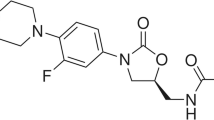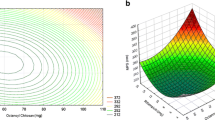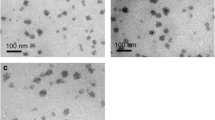Abstract
Purpose
Pulmonary infection namely tuberculosis is characterized by alveolar macrophages harboring a large microbe population. The chitosan nanoparticles exhibit fast extracellular drug release in aqueous biological milieu. This study investigated the matrix effects of chitosan nanoparticles on extracellular drug diffusion into macrophages.
Methods
Oligo, low, medium and high molecular weight chitosan nanoparticles were prepared by nanospray drying technique. These nanoparticles were incubated with alveolar macrophages in vitro and had model drug sodium fluorescein added into the same cell culture. The diffusion characteristics of sodium fluorescein and nanoparticle behavior were investigated using fluorescence microscopy, scanning electron microscopy, differential scanning calorimetry and Fourier transform infrared spectroscopy techniques.
Results
The oligochitosan nanoparticles enabled macrophage membrane fluidization with the extent of sodium fluorescein entry into macrophages being directly governed by the nanoparticle loading. Using nanoparticles made of higher molecular weight chitosan, sodium fluorescein permeation into macrophages was delayed due to viscous chitosan diffusion barrier at membrane boundary.
Conclusion
Macrophage-chitosan nanoparticle interaction at membrane interface dictates drug migration into cellular domains.







Similar content being viewed by others
Abbreviations
- Abs:
-
Absorbance
- DD:
-
Deacetylation degree
- DSC:
-
Differential scanning calorimetry
- EDTA:
-
Ethylene diamine tetraacetate
- FTIR:
-
Fourier transform infrared spectrometry
- HCS:
-
High molecular weight chitosan
- HIV:
-
Human immunodeficiency virus
- KBr:
-
Potassium bromide
- LCS:
-
Low molecular weight chitosan
- MCS:
-
Medium molecular weight chitosan
- MTT:
-
(3-(4,5-dimethylthiazol-2-yl)-2,5-diphenyltetrazolium bromide
- OCS:
-
Oligochitosan
- TIRF:
-
Total internal reflection fluorescence
References
González-Juarrero M, O’Sullivan M. Optimization of inhaled therapies for tuberculosis: the role of macrophages and dendritic cells. Tuberculosis. 2011;91:86–92.
Patel B, Gupta N, Ahsan F. Particle engineering to enhance or lessen particle uptake by alveolar macrophages and to influence the therapeutic outcome. Eur J Pharm Biopharm. 2015;89:163–74.
Anisimova YV, Gelperina SI, Peloquin CA, Heifets LB. Nanoparticles as antituberculosis drugs carriers: effect on activity against Mycobacterium tuberculosis in human monocyte-derived macrophages. J Nanopart Res. 2000;2:165–71.
Vyas SP, Kannan ME, Jain S, Mishra V, Singh P. Design of liposomal aerosols for improved delivery of rifampicin to alveolar macrophages. Int J Pharm. 2004;269:37–49.
Yoder MA, Lamichhane G, Bishai WR. Cavitary pulmonary tuberculosis: the Holy Grail of disease transmission. Curr Sci. 2004;86(1):74–81.
Jordao L, Vieira OV. Tuberculosis: new aspects of an old disease. Int J Cell Biol. 2011. doi:10.1155/2011/403623.
Gengenbacher M, Kaufmann SHE. Mycobacterium tuberculosis: success through dormancy. FEMS Microbiol Rev. 2012;36(3):514–32.
Verschoor JA, Baird MS, Grooten J. Towards understanding the functional diversity of cell wall mycolic acids of Mycobacterium tuberculosis. Prog Lipid Res. 2012;51:325–39.
Bach H, Papavinasasundaram KG, Wong D, Hmama Z, Av-Gay Y. Mycobacterium tuberculosis virulence is mediated by PtpA dephosphorylation of human vacuolar protein sorting 33B. Cell Host Microbe. 2008;3:316–22.
Wong D, Bach H, Sun J, Hmama Z, Av-Gay Y. Mycobacterium tuberculosis protein tyrosine phosphatase (PtpA) excludes host vacuolar-H+−ATPase to inhibit phagosome acidification. Proc Natl Acad Sci U S A. 2011;108:19371–6.
Wong D, Chao JD, Av-Gay Y. Mycobacterium tuberculosis-secreted phosphatases: from pathogenesis to targets for TB drug development. Trends Microbiol. 2013;21(2):100–9.
Dube D, Agrawal GP, Vyas SP. Tuberculosis: from molecular pathogenesis to effective drug carrier design. Drug Discov Today. 2012;17(13/14):760–73.
Gill S, Löbenberg R, Ku T, Azarmi S, Roa W, Prenner EJ. Nanoparticles: characteristics, mechanisms of action, and toxicity in pulmonary drug delivery – a review. J Biomed Nanotechnol. 2007;3(2):107–19.
Hughes GA. Nanostructure-mediated drug delivery. Nanomed: Nanotechnol Biol Med. 2005;1(1):22–30.
Farokhzad OC, Langer R. Impact of nanotechnology on drug delivery. Am Chem Soc Pub. 2009;3(1):16–20.
Lee SH, Heng D, Ng WK, Chan H-K, Tan RBH. Nano spray drying: a novel method for preparing protein nanoparticles for protein therapy. Int J Pharm. 2011;403(1–2):192–200.
Plapied L, Duhem N, des Rieux A, Préat V. Fate of polymeric nanocarriers for oral drug delivery. Curr Opin Colloid Interface Sci. 2011;16(3):228–37.
Ruge CA, Kirch J, Cañadas O, Schneider M, Perez-Gil J, Schaefer UF, et al. Uptake of nanoparticles by alveolar macrophages is triggered by surfactant protein A. Nanomed: Nanotechnol Biol Med. 2011;7:690–3.
Berger J, Reist M, Mayer JM, Felt O, Gurny R. Structure and interactions in chitosan hydrogels formed by complexation or aggregation for biomedical applications. Eur J Pharm Biopharm. 2004;57(1):35–52.
Wong TW. Chitosan and its use in design of insulin delivery system. Rec Pat Drug Deliv Formulat. 2009;3(1):8–25.
Bernkop-Schnürch A, Dünnhaupt S. Chitosan-based drug delivery systems. Eur J Pharm Biopharm. 2012;81(3):463–9.
Shukla RK, Tiwari A. Carbohydrate polymers: applications and recent advances in delivering drugs to the colon. Carbohydr Polym. 2012;88(2):399–416.
Feng J, Zhao L, Yu Q. Receptor-mediated stimulatory effect of oligochitosan in macrophages. Biochem Biophys Res Commun. 2004;317:414–20.
Xia W, Liu P, Zhang J, Chen J. Biological activities of chitosan and chitooligosaccharides. Food Hydrocoll. 2011;25:170–9.
Yong SK, Wong TW. Chitosan for body weight management: current issues and future directions. In: Kim S-K, editor. Marine nutraceuticals: prospects and perspectives. USA: CRC Press; 2013. p. 151–68.
Wong TW, Sumiran N. Drug release property of chitosan-pectinate beads and its changes under the influence of microwave. Eur J Pharm Biopharm. 2008;69:176–88.
Wong TW, Nurulaini H. Sustained-release alginate-chitosan pellets prepared by melt pelletization technique. Drug Dev Ind Pharm. 2012;38(12):1417–27.
Rajan M, Raj V. Formation and characterization of chitosan-polylactic acid-polyethylene glycol-gelatin nanoparticles: a novel biosystem for controlled drug delivery. Carbohydr Polym. 2013;98:951–8.
Syed Mohamad Al-Azi SO, Tan YTF, Wong TW. Transforming large molecular weight pectin and chitosan into oral protein drug nanoparticulate carrier. React Funct Polym. 2014;84:45–52.
Kelly C, Jefferies C, Cryan SA. Targeted liposomal drug delivery to monocytes and macrophages. J Drug Deliv. 2011. doi:10.1155/2011/727241.
Boonsongrit Y, Mitrevej A, Mueller BW. Chitosan drug binding by ionic interaction. Eur J Pharm Biopharm. 2006;62:267–74.
Huang X, Du YZ, Yuan H, Hu F-Q. Preparation and pharmacodynamics of low-molecular-weight chitosan nanoparticles containing insulin. Carbohydr Polym. 2009;76:368–73.
Shimariza Ashikin WHN, Wong TW, Law CL. Plasticity of hot air-dried mannuronate- and guluronate-rich alginate films. Carbohydr Polym. 2010;81:104–13.
Bagheri-Khoulenjani S, Taghizadeh S, Mirzadeh H. An investigation on the short-term biodegradability of chitosan with various molecular weights and degrees of deacetylation. Carbohydr Polym. 2009;78:773–8.
Wasikiewicz JM, Yeates SG. Green molecular weight degradation of chitosan using microwave irradiation. Polym Degrad Stab. 2013;98:863–7.
Kadir A, Mohd Mokhtar MT, Wong TW. Nanoparticulate assembly of mannuronic acid- and guluronic acid-rich alginate: oral insulin carrier and glucose binder. J Pharm Sci. 2013;102:4353–63.
Andrews GP, Laverty TP, Jones DS. Mucoadhesive polymeric platforms for controlled drug delivery. Eur J Pharm Biopharm. 2009;71:505–18.
Han Y, Zhao L, Yu Z, Feng J, Yu Q. Role of mannose receptor in oligochitosan-mediated stimulation of macrophage function. Int Immunopharmacol. 2005;5:1533–42.
Xu J, Zhao X, Wang X, Zhao Z, Du Y. Oligochitosan inhibits Phytopthora capisi by penetrating the cell membrane and putative binding to intracellular targets. Pestic Biochem Physiol. 2007;88:167–75.
Chibowski E, Hotysz L, Szcześ A. Time dependent changes in zeta potential of freshly precipitated calcium carbonate. Colloids Surf A: Physicochem Eng Asp. 2003;222:41–54.
Li XF, Feng XQ, Yang S, Fu G-Q, Wang T-P, Su Z. Chitosan kills Escherichia coli through damage to be of cell membrane mechanism. Carbohydr Polym. 2010;79:493–9.
Liu H, Du Y, Wang X, Sun L. Chitosan kills bacteria through cell membrane damage. Int J Food Microbiol. 2004;95:147–55.
ACKNOWLEDGMENTS AND DISCLOSURES
The authors wish to express their heart-felt gratitude to Universiti Teknologi MARA for fund (0141903) and facility support.
Author information
Authors and Affiliations
Corresponding author
Rights and permissions
About this article
Cite this article
Chachuli, S.H.M., Nawaz, A., Shah, K. et al. In Vitro Investigation of Influences of Chitosan Nanoparticles on Fluorescein Permeation into Alveolar Macrophages. Pharm Res 33, 1497–1508 (2016). https://doi.org/10.1007/s11095-016-1893-5
Received:
Accepted:
Published:
Issue Date:
DOI: https://doi.org/10.1007/s11095-016-1893-5




